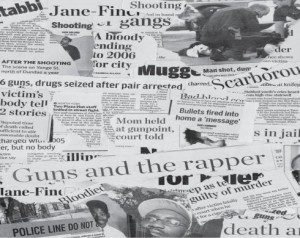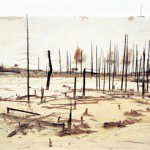It’s a Crime
Toronto streets aren't "nighttime killing fields"—but it's easy to say they are
Chuckie smashes the metal pipe into the side of Freshy’s face. Freshy hits the cement with a thud. Before the 16-year-old knows what’s happening, he’s pummelled by half a dozen guys wearing heavy winter jackets and thick-soled basketball shoes. Curses fly through the night air near the intersection of Jane Street and Finch Avenue in northwest Toronto. Mark Simms keeps his eye to the viewfinder, shooting the scene with a PD150 camcorder on loan from CBC’s the fifth estate.
When the beating is over, Freshy gets up, wiping the blood from his eyes. His features are mashed and beginning to swell. He looks around the apartment complex and stumbles toward Simms.
“You all right?” Simms asks.
“Yeah,” he replies, spitting blood onto the asphalt.
Simms, 25, hadn’t planned on bringing more bad press to his neighbourhood. Quite the opposite. In 2004, the aspiring filmmaker helped his friend Paul Nguyen, 26, build a website called Jane-Finch.com. It was around the time Nguyen’s new girlfriend refused to visit their neighbourhood because of its violent reputation. Nguyen and Simms wanted to send out a positive message. They began shooting videos and writing stories for the website about topics such as local celebrations, new businesses and talented artists.
In 2005 their work caught the attention of producers Tamar Weinstein and Jennifer Fowler at the fifth estate. But not for the positive spin. The CBC producers were planning a documentary about young men leaving school and turning to crime, and wondered if Nguyen and Simms, through their intimate local access to Jane-Finch residents, might help. It has been difficult for journalists to gain an entree into Toronto’s low-income communities ever since the so-called “Year of the Gun” in 2005. Residents saw stories of gangs and violence dominate headlines. Crime reporters sometimes covered two or three shooting deaths in a single weekend. The Toronto Star’s Betsy Powell was one reporter who was swept up in the drama of it. She remembers a particularly hyperbolic sentence being added to her story during the editing process: “Elementary school grounds, shopping mall parking lots and playgrounds have become nighttime killing fields.”
“It’s not true!” she later exclaimed to editors, and says “nighttime killing fields” sounded ridiculous. Similar clichés became commonplace when referring to certain neighbourhoods, and residents largely stopped speaking to journalists. People in Toronto communities such as Jane-Finch, Regent Park and Scarborough often refused to answer their doors if they saw television cameras or notepads.
As a result, reporters without the trust of community members were soon forced to rely on sound bites from the few who would talk. This led to stories lacking context. Director and writer Sudz Sutherland, who grew up in Scarborough, was so struck by the hostility between the residents and the press that he added a scene to his 2006 film Doomstown in which a woman screams at a reporter to leave her neighbourhood. “We don’t need your image of us!” she shouts in the CTV drama.
In December 2005, then prime minister Paul Martin spoke at a press conference in Jane-Finch, promising tougher laws on handguns. Two weeks later, 15-year-old Jane Creba was shot and killed while shopping with family near the Eaton Centre in downtown Toronto, making guns an even hotter topic. By this time, Weinstein and Fowler had already contacted Simms and Nguyen. After some preliminary discussion, the fifth estate gave the young men a virtually limitless supply of mini-DVDs and told them to “go out and start shooting things.” They spent nine months practically living with three subjects – young men of different ethnicities – watching them record music, look for jobs, play with guns and sell drugs. In return, their footage aired on national television, in a documentary called Lost in the Struggle.
Simms stares out the window of a Tim Hortons at the corner of Jane and Finch. He sips his double-double coffee and watches the rain hit the parking lot of a discount grocery store. “See that girl over there?” Simms turns and asks. “You recognize her? She was in the documentary.” The girl, walking with a doughnut in her hand, had bought drugs from one of the subjects in the film.
“Excellent documentary, man!” someone interrupts, slapping Simms’s back as he walks past him in the cramped coffee shop. Simms turns and shakes the man’s hand.
“Thanks,” he says, smiling.
Simms says most people are happy with the documentary. “A few people are not okay with it,” he adds. “It showed the area in a negative way. But it also showed reality.” He says it took time for many residents to accept the portrayal.
Journalists have tried for years to gain access to people in communities such as Jane-Finch, with little or no success. Toronto Sun crime reporter Rob Lamberti approached members of gangs, including Bloods and Crips, but never got further than a brief conversation. “It usually ends with a seven-letter word with a hyphen in the middle of it,” he says. “You’ve got to learn how to take that. It’s just the price of doing business.”
Lamberti received his first death threat about 20 years ago after covering a spree of gang violence in the city. He gave the letter to police, who treated it seriously but didn’t find the source. “I’d still love to sit down with these people, spend a day or two with them and just be the observer,” he says in a grizzled voice. But he understands that acceptance isn’t earned in a day. “People on the street think you have no time for them, that you’re going to write the story and then disappear into the woodwork – which is a fair criticism because, ultimately, that’s what happens.”
On a warm autumn afternoon in Regent Park, outside a small brick community centre, a group of young men sit around a wading pool. There are rows of small houses behind them and, in the distance, luxury downtown towers. I approach them, holding a notepad in my hand.
“Just keep walking,” says a boy in a black hoodie and baggy jeans. I tell him I’m writing a story and want to talk about the media. Someone in a leather jacket asks if I have any smokes. Eventually they start speaking to me.
“What do you think about journalists?” I ask.
“I don’t like them,” the boy in the hoodie says bluntly. “Both them and cops. They come down here for one day and they think they know us. They think everyone’s a fucking gangster.”
As I take notes, a heavy young man walks behind me. He reads the scribbles over my shoulder while talking to someone on a cellphone. When I ask for their names, the looks on their faces tell me the answer. “We’re done here,” says the young man in front of the pool.
Walking around Regent Park, as in many of Toronto’s marginalized communities, it’s easy to notice the negatives. The first thing I see as I head to an interview is a mother with long hoop earrings pushing a stroller and swearing at her toddlers. Farther away, there are men in ill-fitting denim lingering outside a storefront and sucking on cigarette butts. What I don’t hip-see are the mothers who line up at 6 and 7 a.m. in front of bus stops on their way to work; the community volunteers who take kids on after-school trips and teach reading workshops; the students who make their way to school each day, returning home a few hours later to do their homework.
I follow a broken cement sidewalk to Nelson Mandela Park Public School, just east of downtown Toronto. Inside, teacher Elizabeth Schaeffer passes out newspapers to Grade 7 and 8 students. She asks them to cut out articles about young people. Last time Schaeffer taught this lesson, she asked students to bring their own newspapers. They brought in copies of Metro and 24 Hours, free commuter dailies that have little news copy. This time, she makes sure all the major papers are available to snip. The clippings are sorted according to sex, race and content and the results are glued to charts on the walls of the classroom, giving students the opportunity to visualize their findings. Schaeffer waits as confusion sets in on the faces of the predominantly non-white students. One quickly notices the differences among the clippings. On one side are generally positive stories about white children and on the other, stories of violence and criminality among black boys. Schaeffer doesn’t tell the students how to interpret their findings. “The kids ask questions,” she says. They come to their own conclusions about the media. The exercise is designed to make students aware of biases in news gathering and publishing. It’s one of many media literacy lessons that explore stereotypes, which are becoming popular in Ontario classrooms.
Mary Lynn Young, a journalism professor at the University of British Columbia, stresses the importance of context to her students. “How stories are told matters,” she writes in Media magazine. Young says history, cause, consequence and scope are four of the most important things journalists can bring to a story. Schaeffer agrees. If more context were provided in the stories that the students cut out, she says, readers would probably be less inclined to condemn these kids.
But history and context are often overlooked by journalists.
Before he began covering Jane-Finch in 2006, Globe and Mail reporter Joe Friesen knew about the area mostly through the news coverage he had read growing up in Winnipeg. “You hear rumours that it’s an American-style ghetto, but then you get there and you see it’s nothing like that.”
After the Second World War, Jane-Finch was still mainly farmland owned by European settlers. Then, in the late 1960s, apartment complexes and townhouses began appearing to meet the needs of the many low-income families arriving in Toronto. But schools, transportation and other social services took decades to catch up to the population boom. Today, concrete high-rises and payday loan offices dominate the neighbourhood’s landscape and the nearest subway station is two bus rides away from the corner of Jane and Finch.
Friesen quickly realized that there were many community stories not being told. But convincing his editors to let him work the beat was easier than getting people to open up. That would take extra time and effort. He soon found himself in front of half a dozen community leaders gathered in a committee room at 10 San Romanoway, an apartment complex at the heart of Jane-Finch. The group, composed of school board trustee Stephnie Payne and local minister Barry Rieder, among others, wanted to know why Friesen should be accepted into the neighbourhood. After explaining his intentions, Friesen earned an honourary probation period.
Based out of a temporary office in San Romanoway, Friesen wrote about successful school programs, community initiatives and individuals. “‘Jane-Finch’ has become a catchall phrase that suggests poverty, gangs and racial division,” the 29-year-old reporter wrote in the introduction to his series, “but less is told about ordinary life here.” One resident, who had fled violence in Sierra Leone, was teaching a community program aimed at driving black youths away from gangs and toward academic success. Another person was trying to break the cycle of poverty by giving low-income women free daycare and career planning so they could go back to school. Friesen even wrote about the clothes young people wore – how dressing like hip-hop stars didn’t mean they were robbing anyone. “A lot of people were surprised the paper would do this,” says Friesen, now reporting from Afghanistan. “A national newspaper is unlikely to go around writing positive news about any community.”
Friesen says the five months he spent as a journalist in Jane-Finch was an investment that paid off for him as well as for the neighbourhood. He captured the vibrancy of the community, but also showed things as they were. “I wanted to be clear with people that I was a journalist. I’m not on their side. I’m independent.” Once a few of his stories ran – some positive and some negative – he says residents understood where he fit in. Most felt he was fair, although one kid, says Friesen, referred to him as “the cop.”
The “cop” accusation might seem unfair, but a lot of the time journalists do act like police – they come only when there’s trouble. Journalists usually don’t have time to do any community building, a constraint that makes sociologist Rinaldo Walcott skeptical of all news media. The author of Black Like Who? Writing Black Canada points out that the people covering marginalized areas usually have no connection to them. “Journalists are often deployed into communities they don’t live in, that they have no relationship to,” says the University of Toronto professor, who argues that there should be more community reporters. “We get stories of the rich, white and wealthy when they’re having their parties,” Walcott says. “The same thing needs to be extended to our working-class communities. If we can find the energy and skill to write about how Conrad Black may or may not be applying for Canadian citizenship, why can’t we do the same about the life of an ‘ordinary’ Canadian?”
Walcott argues that blood and guts remain the focus even when the story is innocuous. “For instance,” he says, “when they do a story on the annual picnic, they say the people here need the picnic because this is a crime-ridden neighbourhood, so crime still dominates the story. I can understand why some people in the communities respond the way they do – who wants to hear only bad things about themselves all the time?”
Fred Kuntz, the Star’s editor-in-chief, says he understands Walcott’s view but hesitates to condemn his newspaper for covering major crime stories. “It’s easy to blame the messenger,” he says. “That being said, I think we can always do a better job. This is not utopian, it’s not perfection.” In any case, having one community reporter in each of the hundreds of neighbourhoods in Toronto is not financially feasible. “I’m sympathetic to the underlying sentiment,” Kuntz says, “but I’d like to think that smart crime reporters get to the root causes of crime too.”
No one could accuse CityTV’s Dwight Drummond of being another judgmental outsider who parachutes into Jane-Finch when crimes occur. He says he’s happy to bring a local perspective to the area he grew up in. He began working at chum Ltd. as a security person while in university, coming in during Electric Circus, a Friday night dance show. “I’ve worked as a floor director, cameraman, assignment editor, videographer… I can keep going,” says the 39-year-old reporter with his characteristic grin. One of the more infamous stories he’s covered was the trial of Craig Patrick for the murder of three-year-old Brianna Davy in 1999. Drummond was scribbling in a notepad inside the courtroom when Justice Eugene Ewaschuk read out the address of the accused – 10Turf Grassway, apartment 204, in Jane-Finch. “That was my apartment!” thought Drummond, who had grown up in that very unit with his mother.
“It’s weird being that close to it,” says the reporter. Drummond hears things in local shops and over drinks with friends that most reporters don’t. And while he admits that crime reporting can be a pretty negative thing, he’s confident that other journalists in his newsroom balance the coverage with more positive stories. “I’m speaking at a charity organization next week,” he says. “I’m sure someone from City will cover it.”
A Jamaican immigrant, Drummond grew up in the Jane-Finch corridor. He remembers going to the Ontario Science Centre as a student and realizing the effect news had on people. When chaperones from other schools heard where Drummond and his classmates had come from, they started “grabbing kids and running like we had the cooties or something.” That’s when he started thinking about covering news himself.
As for the next generation in Jane-Finch, Nguyen and Simms look up to Drummond. They say he’s not necessarily a better reporter than the rest, but they trust that he won’t sensationalize the story. “He’s around, sometimes with a camera and sometimes just to hang out,” Nguyen says. “Others just want to do their story and get out of here.”














